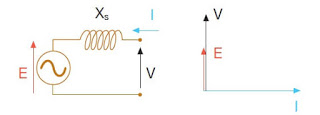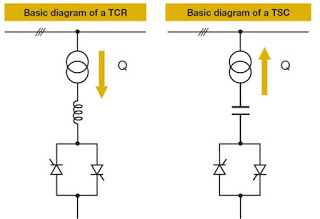Reactive Power Generation and Compensation,Advantages
• synchronous alternators;
• synchronous compensators (SC)
• static var compensators (SVC)
Reactive power using synchronous alternators
Synchronous alternators are the main machines used for the generation of electrical energy. They are intended to supply electrical power to the final loads through transmission and distribution systems. Besides, without going into technical details, by acting on the excitation of alternators, it is possible to vary the value of the generated voltage and consequently to regulate the injections of reactive power into the network, so that the voltage profiles of the system can be improved and the losses due to Joule effect along the lines can be reduced.
Reactive power generation using synchronous compensators
They are synchronous motors running no-load in synchronism with the network and having the only function to absorb the reactive power in excess (under excited operation) or to supply the missing one (overexcited operation).
under-excited synchronous compensator
 |
|
under-excited synchronous compensator reactive power
|
over-excited synchronous compensator
 |
|
over-excited synchronous compensator
|
E : e.m.f. induced in the stator phases
V: phase voltage imposed by the network to the alternator terminals
I: stator current
Xs: stator reactance
These devices are used mainly indefinite nodes of the power transmission and sub-transmission network for the regulation of voltages and of reactive power flows. The use of synchronous compensators in power distribution networks is not favorable from an economic point of view because of their high installation and maintenance costs.
Static var compensators
 |
|
Static var compensators
|
The considerable development of power electronics is encouraging the replacement of synchronous compensators with static systems for the control of the reactive power such as for example TSC (thyristor switched capacitors) and TCR (thyristor controlled reactors). These are an electronic version of the reactive power compensation systems based on electromechanical components in which, however, the switching of the various capacitors is not carried out through the opening and closing of suitable contactors, but through the control carried out by couples of antiparallel thyristors.
TSC allows a step-by-step control of the reactive power delivered by groups of capacitors, whereas with TCR a continuous control of the reactive power drawn by the inductors is possible. By coupling a TSC with a TCR it is possible to obtain a continuous modulated regulation of the delivered/drawn reactive power. From the point of view of applications, these devices are used above all in high and very high voltage networks.
Advantages of reactive power compensation
1) Improves system power factor
2) Reduces network losses
3) Avoid penalty charges from utilities for excessive consumption of reactive power
4) Reduces cost and generates higher revenue for the customer
5) Increases system capacity and saves cost on new installations
6) Improves voltage regulation in the network
7) Increases power availability
Read also
Reference:Power factor correction and harmonic filtering in electrical plants ABB